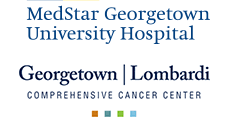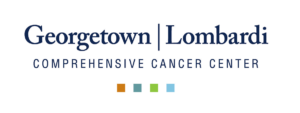Where the Money Goes

Georgetown Lombardi Comprehensive Cancer Center
Georgetown Lombardi Comprehensive Cancer Center is deeply grateful for your support of our pioneering research on the prevention, treatment, and curing of cancer. For more than 40 years, Georgetown Lombardi has been the only National Cancer Institute- designated Comprehensive Cancer Center in the Washington, DC area. Georgetown Lombardi produces cutting-edge research that includes personalized medicine (customizing care plans based on the patient’s genes and tumor structure to improve patient outcomes), immunotherapy (engaging the patient’s immune system to effectively fight cancer), and other ground-breaking innovations that may lead to the next generation of cancer treatments. As a community leader, Georgetown Lombardi also addresses cancer disparities among minority and underserved populations in the area through community-based research and clinical navigation programs focused on cancer prevention, diagnosis, and treatment.
All donations raised through events such as SQUASH CANCER will be used to impact every aspect of the Center’s mission.
Current Research:
New Immunotherapy Combination Tolerable, Effective in Patients with Kidney Cancer
Combining an anti-angiogenesis agent, which blocks blood vessel formation, with an immunotherapy agent was found to have promising anti-tumor activity and no unexpected side effects in an early-phase clinical trial in patients with advanced kidney cancer who had not been previously treated, according to a researcher at the Georgetown Lombardi Comprehensive Cancer Center who led this study. “Our results are unprecedented. The combination doubled the efficacy of the drugs when used alone and the treatment was found to be tolerable,” says Michael B. Atkins, MD, deputy director, Georgetown Lombardi Comprehensive Cancer Center and principal investigator for the study. “Specifically, over 90 percent of patients exhibited tumor shrinkage and the disease was kept under control for a median of over 20 months.”
Two Agents Deliver Knock-Out Punches to Ewing Sarcoma
When combined with an already FDA-approved chemotherapy, a novel agent developed by researchers at Georgetown Lombardi Comprehensive Cancer Center, appears to halt the ability of Ewing sarcoma to grow and progress. The finding, in cell lines and animal models, warrants clinical investigation to see if the combination would be an effective treatment as well as a less toxic alternative to current therapy for the rare bone cancer, the researchers say. The study, published in the journal Science Signaling, tests a combination of YK-4-279, the compound developed at Georgetown, with vincristine in laboratory and mice studies. Vincristine is one of the chemotherapy drugs now used to treat Ewing sarcoma. “Each of the two drugs impacts the cancer cell’s ability to survive, but they do it in a way that magnifies their effectiveness compared to if they were used alone. It’s like a left hook followed by an uppercut,” says the study’s senior investigator, Jeffrey Toretsky, MD, a pediatric oncologist and researcher at Georgetown Lombardi.
Schlegel Strives To Create Another Cervical Cancer Game Changer
For more than three decades, Richard Schlegel, MD, PhD, has largely been focused on one goal: decreasing the incidence of cervical cancer, the second leading cause of cancer deaths in women globally. As a co-inventor, nearly two decades ago, of the Georgetown-owned technology that led to a human papillomavirus (HPV) vaccine, Schlegel, chair of Georgetown University School of Medicine’s pathology department, has helped prevent millions of women from becoming infected with a virus that can lead to cervical cancer. While the HPV vaccine has been a game changer, Schlegel’s recent research may lead to another advance by treating women already infected with HPV and a precancerous condition that often leads to the development of cervical cancer. It involves a novel treatment delivery system with a repurposed anti-malarial drug.
Beyond Research:
In addition to the ground-breaking work happening in our labs, Lombardi Comprehensive Cancer Center offers support services for our patients battling cancer. Inspired by the Jesuit value cura personalis, your gifts support our patients by helping us “care for the whole person.” Amongst other services, this support comes in the form of community outreach, psychosocial services, and our Arts & Humanities program.
CBCC Patient Navigators Help Women Overcome Obstacles to Health Care Access
Women in the District of Columbia have the highest breast cancer mortality rates in the nation. Low-income minority women are more likely to face barriers to health care access and are at a higher risk of developing the most aggressive types of breast cancer. As part of the Office of Minority Health and Health Disparities Research at Georgetown Lombardi Comprehensive Cancer Center, the Capital Breast Care Center (CBCC) was founded to ensure that all women in DC have access to the breast care that they need. “Patient navigators address barriers patients face when they need to get services,” said Marquita Iddirisu, MPH, CBCC patient navigator and community outreach coordinator. Whether patients have concerns about paying for breast cancer screenings, getting to appointments or are simply afraid to get a mammogram, CBCC patient navigators are there to help.
The Georgetown Lombardi Arts and Humanities Program (AHP) promotes cura personalis, or care of the whole person, for MedStar Georgetown University Hospital (MGUH) patients, family members, caregivers, medical staff and visitors through its programs of music, expressive writing, dance and visual arts. These therapeutic art modalities encourage a creative and constructive response to illness. Classes, workshops, bedside visits, exhibitions, environmental enhancements and educational programs contribute to promoting an optimum life experience for those who encounter and interact with the AHP at MGUH. The AHP is lead by these guiding principles: the best patient care begins with the best staff care, artists are valuable members of patient care teams, healthcare professionals need to take time for self-care and a creative healthcare environment benefits all communities involved.

